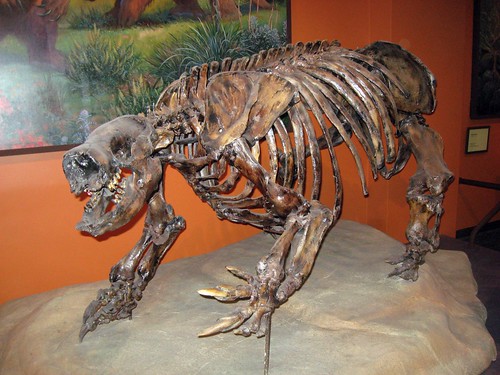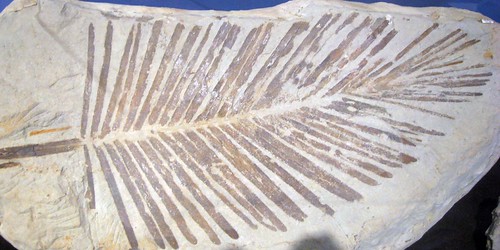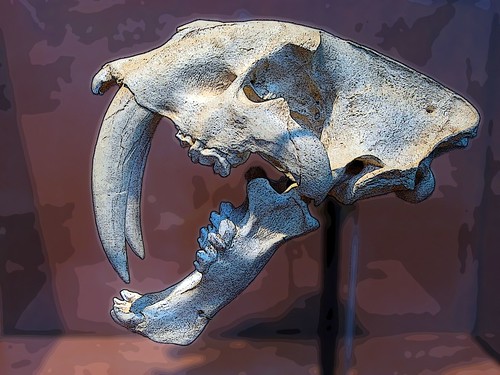I've been meaning to get caught up and let you have some of the reviews of the "nature attractions" I visited towards the end of last year. One of these - visited rather quickly - was the San Diego Natural History Museum (hereafter "SDNHM"). First up the museum is, when viewed from the outside, housed in a rather impressive multi-story building in Balboa Park (which is basically San Diego's museum district. Sadly on entering it becomes apparent that the museum is smaller than one might expect from the outside as two of the floors are basically balconies around a central attrium. These are populated with some rather nice photography and the odd interesting specimen but basically add very little to the museum itself. I understand the items on the walls change regularly as part of regular exhibitions so this is a moveable feast.
Inside the "proper" bits of the SDNHM however are some very nice exhibits. My favourite was a gallery representing pleistocene california with some really cool extinct mammal specimens including a nice Mastodon and a rather impressive Harlan's Ground sloth. A large fibreglass(?) American lion waiting perched on a hill to pounce was a clever way to inform visitors that, yes, America used to have lions. Also nice were the huge images behind each fossil depicting the animal in life which due to their continuity and scale almost gave the impression of walking through Pleistocene San Diego.
Moving through the museum there was an interesting section on waterborne mammals and other creatures that yielded the giant sea cow replica that inspired this post. What the image did not reveal is that only half the replica is true to "life" and the other half is a cutaway revealing the fossil interior. A number of these appear throughout the museum and I thought they were an excellent way of linking the fossil shape to the animals when alive (something the images in the pleistocene gallery also did well). I must commend the museum for this as I could see its educational benefits very clearly although I will admit it irritated me slightly on a personal level by limiting my angles for photography and the entirety of the "fossil mysteries" section was done very well with clearly defined areas and a very logical progression. There was even a fossil cycad which I was happy to see.
The other major exhibition was on "water" and I must confess this was a slight let down for me as it consisted of a lot of interactive piece, video and so forth which I'm afraid leave me cold in museums. It seemed to be done well enough though and was clearly an important topic to cover from a San Diegan's perspective. The museum made a clear effort to link items to California and San Diego which I felt was worthwhile and appropriate.
All in all I felt SDNHM was a nice little museum. It did what it did well and in an interesting and well interpreted fashion. This is a not a natural history museum in the grand traditions of New York or London but is an excellent local museum. Don't allow yourself too long to get round it as its not big but its proximity to San Diego zoo (of which more later) could make it a nice little nature education two-fer if your feet aren't too tired by a day at the zoo.
I give it 7 golden rays out of 10.
Inside the "proper" bits of the SDNHM however are some very nice exhibits. My favourite was a gallery representing pleistocene california with some really cool extinct mammal specimens including a nice Mastodon and a rather impressive Harlan's Ground sloth. A large fibreglass(?) American lion waiting perched on a hill to pounce was a clever way to inform visitors that, yes, America used to have lions. Also nice were the huge images behind each fossil depicting the animal in life which due to their continuity and scale almost gave the impression of walking through Pleistocene San Diego.
Moving through the museum there was an interesting section on waterborne mammals and other creatures that yielded the giant sea cow replica that inspired this post. What the image did not reveal is that only half the replica is true to "life" and the other half is a cutaway revealing the fossil interior. A number of these appear throughout the museum and I thought they were an excellent way of linking the fossil shape to the animals when alive (something the images in the pleistocene gallery also did well). I must commend the museum for this as I could see its educational benefits very clearly although I will admit it irritated me slightly on a personal level by limiting my angles for photography and the entirety of the "fossil mysteries" section was done very well with clearly defined areas and a very logical progression. There was even a fossil cycad which I was happy to see.
fossil Cycadales species
The other major exhibition was on "water" and I must confess this was a slight let down for me as it consisted of a lot of interactive piece, video and so forth which I'm afraid leave me cold in museums. It seemed to be done well enough though and was clearly an important topic to cover from a San Diegan's perspective. The museum made a clear effort to link items to California and San Diego which I felt was worthwhile and appropriate.
Articulated Smilodon fatalis skull/jaw
All in all I felt SDNHM was a nice little museum. It did what it did well and in an interesting and well interpreted fashion. This is a not a natural history museum in the grand traditions of New York or London but is an excellent local museum. Don't allow yourself too long to get round it as its not big but its proximity to San Diego zoo (of which more later) could make it a nice little nature education two-fer if your feet aren't too tired by a day at the zoo.
I give it 7 golden rays out of 10.




No comments:
Post a Comment